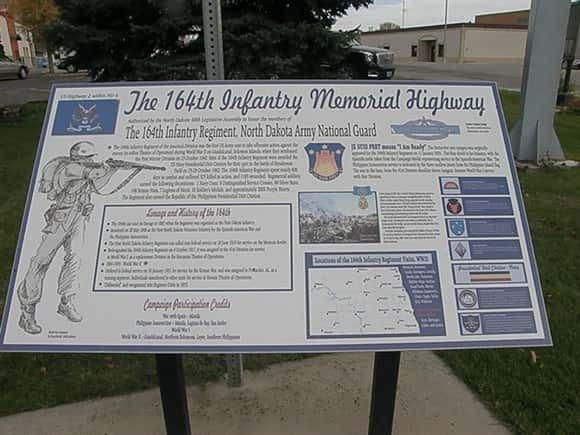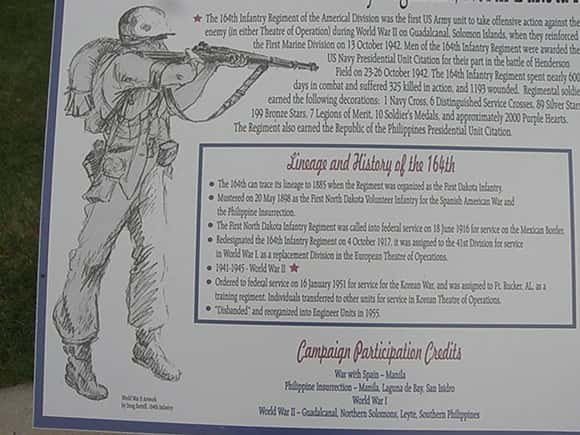BISMARCK, N.D. (NewsDakota.com) – The last reunion of North Dakota’s 164th Infantry Regiment will be held exactly seventy-five years to the day of the World War II event that made them famous.
An open house for the public will be held Saturday, October 14th, on the upper floor of the Energy Center at Bismarck State College. The display area will open at 9 am and continue until 5 pm. Collections of 164th Infantry uniforms, journals, photos, memorabilia, military equipment and reference materials will be available for viewing.
On October 13, 1942, the 164th Infantry landed on Guadalcanal to become the first US Army unit to offensively engage the enemy when it reinforced the 1st Marine Division against the Japanese in World War II. The Oct. 14 event will commemorate the rich history of the 164th Infantry Regiment and highlight its service in World War II.
A special time to chat with the 164th veterans of Guadalcanal, Bougainville and the Philippines campaigns is scheduled at 1 p.m. in the second floor theater at the Energy Center. Dr. Larry Skogen, president of Bismarck State College, will host the interactive event to discuss the battles and will also field questions from the audience.
A short program will take place in the isplay area prior to a 2 p.m. concert by the North Dakota Army National Guard’s 188th Army Band. The lineage of the 188th Band is directly connected to the 164th Infantry. Both the concert band and the exceptional jazz band will entertain with patriotic tunes and WWII era swing.
The event is free and open to the public. Inquiries may be addressed to Editor164thInfantryNews@hotmail.com or 701-989-2924.
History: Landing at Guadalcanal October 13, 1942
Seventy-five years ago, Company M, Grand Forks, lost their first soldier on that very first day on Guadalcanal, as the enemy navy welcomed the newcomers with 14-inch rounds that rocked the earth and made toothpicks out of 60-foot-tall palm trees. The shelling was horrific.
Louis J Hanson, a farmer from the Jamestown area assigned to Company E noted, “I didn’t think any of us would get out alive.”
After only twelve days on the steamy tropical island, the regiment was thrust into intense fighting against waves of Japanese on the nights of Oct. 24-25
Richard Stevens recalls trudging along the muddy slope of Edson’s Ridge, Guadalcanal, to reinforce the Marines on the thin line that separated the Japanese from the airfield they desperately wanted. Then a National Guard private, now a 95-year-old retired Army colonel, Stevens is the last living member of Company M, 3rd Battalion, 164th Infantry Regiment. Originally from Lawrence, Kansas, Stevens acknowledges that a simple twist of fate caused his transfer from Company M, 137th Infantry, Kansas Army National Guard, to the sister company in the 164th just prior to the North Dakota Regiment’s departure for the South Pacific in March, 1942. Another twist of fate brought Stevens’ 3rd Battalion directly into the fight alongside the Marines during the Second Battle for Henderson Field.
Hanson’s Company E was ‘next door’ helping defend the area that became known as Coffin Corner. Hanson is the last living Co E veteran of Guadalcanal. Both men will tell the tales at the hosted Chat with the Guadalcanal Guys at 1p.m., Oct.14.
Other Soldiers expected to attend are Dennis Ferk, Harry Vadnie, and Aloysius Moszer from Bismarck’s Company A; Doug Burtell, Bowman, who served in the Headquarters Intelligence and Reconnaissance section; and Ralph Oehlke, Enderlin, who joined the 164th Band but transferred to the Anti-Tank Company for the duration the war.
It’s history now. The coveted airfield on Guadalcanal remained in allied hands, thanks in good part to the actions of the 164th. Captain Al Wiest, who had transferred from Jamestown’s Company H to command Company M, would tell the story for the rest of his life about Chesty Puller’s famous comment overheard in the 7th Marine Regiment’s headquarters tent after the battle. “Those farm boys can fight, I can tell you that much!” said Puller, who earned the Navy Cross for that battle, as did Jamestown’s Lt. Col. Robert K. Hall, commander of the 164th 3rd battalion. The Regiment earned the trust of the Marines and was awarded the Navy Presidential Unit Citation.
How important was Guadalcanal? Rear Admiral Raizo Tanaka, one of the greatest tactical commanders of destroyer forces in the Japanese Navy, said “There is no question that Japan’s doom was sealed with the closing of the struggle for Guadalcanal”.


